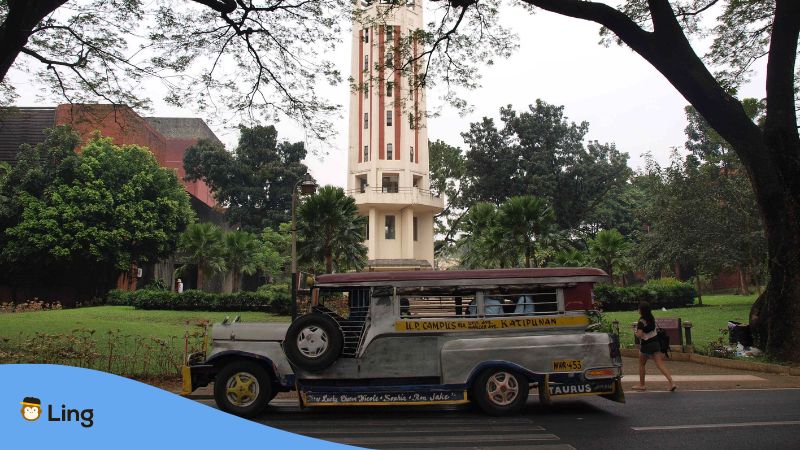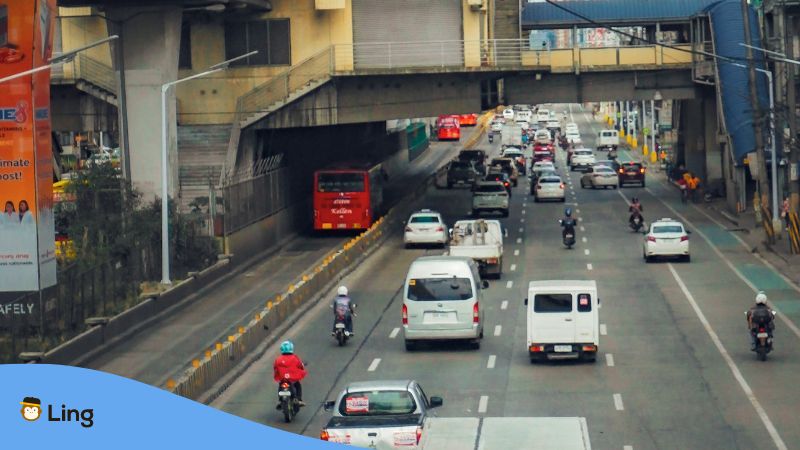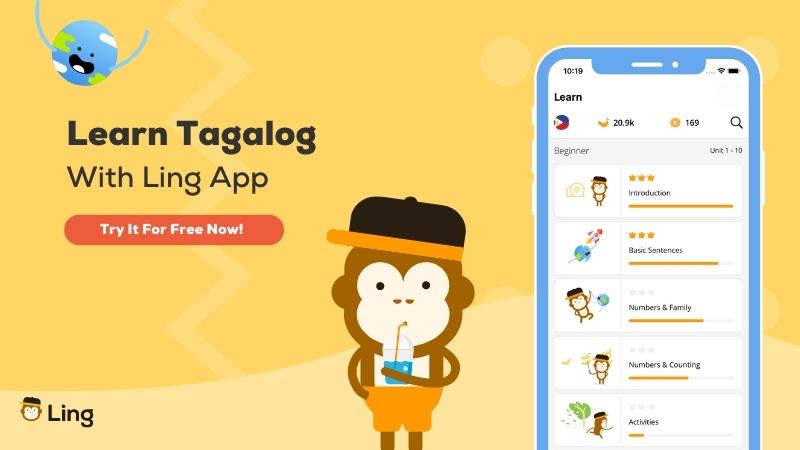Are you planning to drive in the Philippines? Learn the easy Tagalog words for driving (pagmamaneho) we rounded up in this post so that you can communicate more effectively with the locals.
Driving can be an enjoyable experience, but safety should always come first. When traveling to the Philippines, you may encounter various vehicles like cars, motorcycles, jeepneys, or pedicabs. As a passenger, knowing basic Tagalog phrases can help you communicate with drivers and learn more about Filipino culture.
But if you have a valid international driver’s license and plan to drive, these words and phrases will be incredibly useful in many situations. It’s also possible for foreigners to rent a car in the Philippines, but it’s important to note that driving in the country can be challenging due to traffic and road conditions. Thus, we highly recommend that visitors familiarize themselves with local driving laws and customs and exercise caution while driving in the country.

Basic Tagalog Words For Driving
The Tagalog word for “drive” is “maneho,” which may not sound familiar to English speakers. However, it’s an excellent starting point for learning Tagalog driving terms. Driving in the Philippines, especially in urban areas like Metro Manila, can be challenging and require lots of patience, especially during rush hour.
To navigate the roads successfully, you must learn basic Tagalog words and phrases that will help you communicate with locals and stay safe on the road. Let’s start with the ones we have rounded up below.
Driving – Pagmamaneho
Example Sentence: Mag-ingat ka sa pagmamaneho. (Be careful when driving.)
The word pagmamamaneho came from “maneho,” which means “drive.” The word “pagmamaneho” means “driving,” which is a noun. If you want to convert it into a verb, you can say nagmamaneho (driving), nagmaneho (drove), or magmamaneho (will drive).
Vehicle – Sasakyan
The next word is sasakyan which is translated to “vehicle” in English. If you’re a foreigner and you don’t have a driver’s license, you cannot drive vehicles, but you can book a ride through different apps. If you want to book a car, you can use the Grab, Angkas, or Uber apps.
Driver – Tagapagmaneho/Tsuper
Example Sentence: Sinabi ko sa tagapagmaneho ang aking pupuntahan. (I told the driver my destination.)
The word tagapagmaneho refers to the person who is driving the vehicle. On the other hand, the word tsuper is a slang word for driver. You’ll mostly hear this in public transportation like jeepneys and buses. Nowadays, you can also see the Tagalized version of the driver, which is “drayber.” This word sounds like the English translation
Overtake – Lagpasan
Example Sentence: Huwag ugaliing lampasan ang ibang sasakyan. (Do not make it a habit to overtake other vehicles.)
Next is the word lagpasan, or overtake in English. You may also hear the word unahan, which means “to come first,” but it can also mean the same when it comes to driving. However, the latter is informal.
Back-Up – Umatras
Example Sentence: Umatras ako para hindi kami magbungguan. (I back up so that we won’t crash.)
The Tagalog word umatras is used when you are backing up. On the other hand, you can use abante/dumiretso, andar if you want to say “to move forward.”
Pull Over/Stop – Huminto
Example Sentence: Huminto kami sa pinakamalapit na kainan. (We pulled over to the nearest restaurant.)
The next word is huminto or pull over/stop in English. However, you might also hear the word “para” in public transportation, which means “stop.”

Park – Parada
Example Sentence: Saan pwedeng pumarada? (Where can I park?)
The word parada means park in English, but when you can also say pumarada if you want to mean “to park.” If you want the Tagalog word for parking lot/area, you can say “paradahan.”
Cut Off – Harangan
Example Sentence: Hinarang ng pulis ang tsuper na hindi sumunod sa ilaw-trapiko. (The police man cut off the driver who did not obey traffic lights.)
If you are familiar with the scene where a traffic officer is chasing a vehicle that did not obey a traffic rule, this is where the word harangan can be perfectly used. It can also mean “to block” in English.
Run Over – Sagasa
Example Sentence: Marami nang nasagasaan sa daang iyan. (There are already lots of people who were run over on that road.)
This word isn’t something that you would want to experience. The word sagasa means run over, while sagasaan means “to run over.”
Slow Down – Bagalan
Example Sentence: Kung ikaw ay malapit sa paaralan, kailangan mong bagalan ang iyong takbo. (If you’re in a school zone, you need to slow down.)
To avoid accidents, you should drive carefully and at a moderate speed. But, if you want to slow down, the right word for that is bagalan. This will come in handy, especially if you have booked an Angkas or JoyRide ride, which is an app for motorcycle TNVS.
Traffic Lights – Ilaw-Trapiko
Example Sentence: Sumunod ka sa ilaw-trapiko. (Follow the traffic lights.)
One of the most important words you should know is the word ilaw-trapiko or traffic lights. Just like in other countries, red (pula) means stop, yellow (dilaw) means to wait, and green (luntian/berde) means to go.
Other Tagalog Words Related To Driving
There are lots of driving words that you should learn in the Tagalog language, but the words above may give you a good head start. Below are more Tagalog driving words that might come in handy when you’re in a vehicle in the Philippines, whether commuting or driving a private vehicle.
| English | Tagalog |
| break | preno |
| car | kotse |
| commute | mag-comute |
| crosswalk | tawiran |
| driver’s license/license | lisensya |
| gas | gasolina |
| gasoline station | gasolinahan/istasyon ng gasolina |
| horn | busina |
| motorcycle | motorsiklo |
| passengers | mga pasahero |
| road | daan |
| steering wheel | manibela |
| speed up | bilisan |
| traffic | trapiko |
| traffic rules | batas-trapiko |
| traffic officer | traffic officer |
| turn right | kumaliwa/lumiko sa kanan |
| turn left | kumanan/ lumiko sa kaliwa |
| wheel | gulong |
Stuck In A Long Drive? Learn A New Language Today!

Whether you’re a passenger in a private vehicle or public transportation, learning a new language is possible with the Ling app. This user-friendly app allows you to learn languages anytime and anywhere, making language learning more accessible than ever before. With its innovative features, you can easily improve your language skills while choosing from a variety of engaging topics related to the Tagalog language and 60+ other languages.
Ready to give it a try? Download it today from the App Store or Play Store to get started!

















